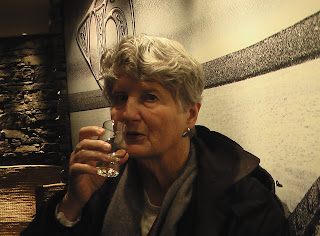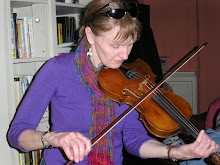You can't be in Orkney without spying old or new Orkney chairs. Locals made these chairs for hundreds of years with materials they had at hand. The chairs combine wood
 for the frame and oat straw coiled and stitched with sisal for the chair backs. We saw the chairs being made first hand at Fraser Anderson's workshop, Orkney Hand-Crafted Furniture, in Kirkwall.
for the frame and oat straw coiled and stitched with sisal for the chair backs. We saw the chairs being made first hand at Fraser Anderson's workshop, Orkney Hand-Crafted Furniture, in Kirkwall.
Just as in chairs of old, he gathers driftwood between November and February. The driftwood, mainly pine or beech, cures for 2 years before he uses the lumber for chairs. The oatstraw is grown locally by his cousin and has to be cut with an old fashioned binder. It takes 4 sheaves for one chair back. Each stalk in the sheaf has to be stripped by hand. It takes up to 3 weeks to complete each chair and Fraser makes up to 30 chairs a year. He is one of 3 professional chair makers on Orkney. Fraser is honoring the tradition by repairing old chairs and designing new shapes and styles of chairs, rockers and stools.
 http://www.orkneyhandcraftedfurniture.co.uk/
http://www.orkneyhandcraftedfurniture.co.uk/
The big island, or as Orcadians call “mainland” is home to numerous stone circles and structures dating back as far as 5000 years. Nowdays, the 17 of the 65 islands that are populated are home to 20,000 people, 100,000 beef cattle, 68,000 sheep and one fishing fleet, on Westray.
We traveled west to the heart of Neolithic Orkney. Modern technolog
 y has shown that the stone monuments above ground are just the tip of the iceberg of all the ancient stone sites under the earth in this heart of the island. There is currently a new archeological dig exploring a newly found site not far from the Standing Stones of Stenness.
y has shown that the stone monuments above ground are just the tip of the iceberg of all the ancient stone sites under the earth in this heart of the island. There is currently a new archeological dig exploring a newly found site not far from the Standing Stones of Stenness.
Michael, our local guide while Andrew had a day off, told us tales and speculations about these sites. Stenness means “stone point” and indeed the tall stones still standing are pointed on top, but just 3100 years old. Also known as the Temple of Moon, couples came to perform a marriage ritual which would bind them together for one year and one day. After that period, they would have to come back to the stones to renew that ritual or to break the contract. Thus was their system of “marriage in installments.” www.orkneyjar.com/history/standingstones/
The Ring of Brodgar once had 60 stones standing. Brodgar means “farm by the bridge.” A ditch, 11 feet deep and 33 feet wide encases the stone ring. One story goes that giants came to this ground to dance. Hands joined, they danced around and around, forming the ditch. They were having so much fun, they didn’t notice the sun rising. When the sun’s rays touched them, they turned to stone, thus forming the stones in the ring. Each Dec 31, they come alive, rise up out of the ground, walk down to the lake an
 d have a drink. Then they go back to the ri
d have a drink. Then they go back to the ri ng and become solid stone for another year. This sounds much more believable when Michael tells the story!
ng and become solid stone for another year. This sounds much more believable when Michael tells the story!
The 2500 year old ring is said to grant the gift of fertility to anyone who runs around it counter clockwise 3x without stopping. Considering the large circumference, this running ritual also meant you were in shape! As we walked the ring, many of us touching each stone, the wind blew us along, urging us to consider what ancient wisdom moved the people to build such impressive sites. What did they know, that we have long forgotten? www.orkneyjar.com/history/brodgar/
Stromness is the 2nd largest town on mainland Orkney with a population of 2000+. We enjoyed a lunch stop here, dining at Julia’s Bistro. This café sits right off the waterfront and had one of the best desserts I ate the entire trip, raspberry almond cake. Several of us on the trip took pictures of our food, me because I like to cook, eat and remember. I also like to help erase the commonly held myth that Scottish food is boring and not tasty.

Maybe that was true in past decades, but these days, food is fresh, locally sourced when possible, and tasty. You don’t have to look for “hormone free” on the milk bottles, because all milk in the UK is hormone free. Orkney cheese is really nice. I purchased some Grimbister Farm cheese with caraway and mature Orkney red cheddar for the group. Combine with a Carr’s cheese cracker, and the tummy is quite satisfied.
Skara Brae was uncovered when a storm hit William Wa
 tt’s farm in 1850 and eroded the beachfront. The settlement wasn’t excavated however until 1928. This fine example of a stone-age community was quite advanced as they even had a sewage sytem and a stone trough area they filled
tt’s farm in 1850 and eroded the beachfront. The settlement wasn’t excavated however until 1928. This fine example of a stone-age community was quite advanced as they even had a sewage sytem and a stone trough area they filled  with water
with water  and hot rocks to steam the sea life they ate. www.orkneyjar.com/history/skarabrae/
and hot rocks to steam the sea life they ate. www.orkneyjar.com/history/skarabrae/
Corrigall Farm Museum in Harr
 ay is a wonderful example of rural agricultu
ay is a wonderful example of rural agricultu ral life on the island. Implements, tools and household furnishings from the 18th-20th century fill the buildings. Inside the buildings are all kinds of fascinating things like a simmon, rope that was made from twining grass, a spoon kaise, for holding cutlery, an ingenious mousetrap, an old Orkney chair, loom, and spinning tools and usually some North Ronaldsay sheep, the breed that eats seaweed! But they were not there today. http://www.orkney.org/museums/
ral life on the island. Implements, tools and household furnishings from the 18th-20th century fill the buildings. Inside the buildings are all kinds of fascinating things like a simmon, rope that was made from twining grass, a spoon kaise, for holding cutlery, an ingenious mousetrap, an old Orkney chair, loom, and spinning tools and usually some North Ronaldsay sheep, the breed that eats seaweed! But they were not there today. http://www.orkney.org/museums/

A tour of the Highland Park Distillery in Kirkwall lead us through the entire process of distilling single malt whiskey from the malting of the barley to the where the magic happens in the aging process. Highland Park single malt has a peaty taste and it light amber in colour. The taste comes from the malting process of roasting the barley with peat.

This is one of just 5 distilleries in Scotland that malts their own barley. The barley comes from mainland Scotland. The barley is soaked in water for two days, so it spr
 outs. Then it is spread out on a concrete floor for 5 days and turned to prevent it from sticking together. The kernels keep germinating on the malting floor. Then the green malt is placed on a mesh floor far above the fire kiln where it gets two firings of 18-20 hours each. The first four layers of peat are used in the first firing to give the barley a smokey flavor. Then it goes through a second firing fueled by coke, a form of coal. This second firing dries the malted barley.
outs. Then it is spread out on a concrete floor for 5 days and turned to prevent it from sticking together. The kernels keep germinating on the malting floor. Then the green malt is placed on a mesh floor far above the fire kiln where it gets two firings of 18-20 hours each. The first four layers of peat are used in the first firing to give the barley a smokey flavor. Then it goes through a second firing fueled by coke, a form of coal. This second firing dries the malted barley.
After malting the grain is turned into a mash. The mash goes through 3 soakings. The distilling of the sugars into alcohol is a two-step process done in huge copper cookers. They age the whisky a minimum of 12 years in both Spanish s
 herry barrels. Nothing like a dram of whisky to settle the stomach before dinner! http://www.highlandpark.co.uk/distillery/
herry barrels. Nothing like a dram of whisky to settle the stomach before dinner! http://www.highlandpark.co.uk/distillery/

Each Wednesday night, the Orkney Accordian and Fiddle Club practices at the Ayre Hotel in Kirkwall. Tonight, being the 4th Wednesday of the week, was “open night” which is a concert. They were joined by the Strathspey and Reel society and played for almost 3 hours. Where is that dance partner when I need him?
Music and bands abound in Orkney. They showcase Orkney and Scotland’s finest in the annual Orkney Folk Music Festival, May 21-24, 2009. www.orkneyfolkfestival.com

No comments:
Post a Comment